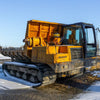Your guide to the daily checks every item of workwear should go through

When you’re working in a high-risk role, the workwear could be the difference between getting injured or staying safe.
For this reason, you want to make sure that your workwear is fit for use every single time you put it on – this means putting it through a few simple checks, every single day.
These checks will help you check that there is nothing wrong with your workwear and no potential hazards that could get in your way while at work.
Here is your guide to the daily checks every item of workwear should go through:
1. Was it hung up overnight?
The way you store your workwear when you’re not using it is extremely important, so you should first check that it was hung up and stored correctly overnight.
If it’s not where you left it, or you find it crumpled up in a corner of a warehouse, you’ll want to be even more careful when it comes to carrying out your checks.
2. When was the last time your workwear was washed?
Washing your workwear is the easiest way to keep your garments clean and free of stains in between use.
Before putting it on, try to remember when the last time it was washed – if it’s been too long, you may want to choose another, fresher garment.
3. Check for any rips or tears
It’s important to give your garments an overall check for any rips or tears that could potentially put you in danger of injury when working with hazardous chemicals, sharp equipment, or other intensive work.
If there are any rips or tears, you should let your manager know immediately as these workwear garments will not be fit for use.
4. Are there any spills or stains on the clothes?
Check for any stains, especially if you work with chemicals or materials that could reduce the protection that your garments offer while working.
5. Do all your zips, buttons etc. work?
When you’re putting your workwear on, check that all the zips, buttons, pockets etc. are not damaged, or not working properly.
6. Double-check places where damage is common e.g. knees, elbows
Finally, there are some areas of workwear that can often get damaged a lot quicker than others – for example, knees if you’re constantly kneeling down, or around the elbows, while you’re moving about.





